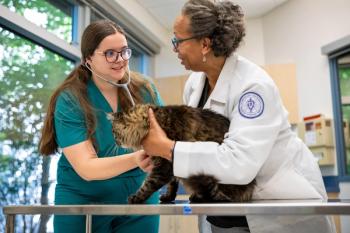
Purdue 2017: Early-Age Spay/Neuter Saves Lives
Although special considerations must be taken when operating on very young puppies and kittens, experts say the benefits of early-age gonadectomy outweigh the risks. Here’s why.
“Early age gonadectomy (EAG) has been shown to be safe, and is an effective way of saving lives,” says Carol A. Fellenstein, DVM, a mobile shelter surgery clinician at Purdue University College of Veterinary Medicine’s Pet Exotic Service in West Lafayette, Indiana. Presenting at the 2017 Purdue Veterinary Conference, Dr. Fellenstein described how early-age spay/neuter programs represent an essential component of a community-wide animal care strategy that only veterinarians can provide.
She discussed some data from studies1-4 that have compared outcomes associated with EAG and traditional-age gonadectomy (TAG). Overall, the data point toward EAG being generally safe for both cats and dogs and leading to few long-term deleterious effects. However, the one exception may be the development of urinary incontinence in female dogs undergoing EAG, Dr. Fellenstein highlighted.
But when the risk of urinary incontinence in EAG female dogs is weighed against all other risks facing animals in shelters, it may be considered less significant, she emphasized.
Waiting until animals have reached puberty before spaying or neutering them simply places an unnecessary burden on shelters, resulting in millions of animals being euthanized. “The vet’s role in a comprehensive community program is to reduce the strain on shelters,” she stressed.
However, she noted the need for veterinarians to consider some important factors associated with operating on pediatric patients, stressing that, “physiologically, they are not just little versions of adult animals.”
For example, because pediatric animals have a higher heart rate, cardiac output, and plasma volume than their adult counterparts, they have a reduced ability to compensate for blood loss. Thus, even a small amount of blood loss can result in a clinically significant anemia in these very young animals, she noted. Their oxygen consumption and respiratory rate are also greater than those of adults, so they need higher oxygen flow rates during surgery—“two to three times that required by adults,” said Dr. Fellenstein.
The lack of body fat in pediatric patients increases their susceptibility to hypothermia. Veterinarians should also be aware that heat loss begins with premedication, she added, especially when vasodilators such as acepromazine are used in an animal that may then wait a few hours until surgery.
Because of their immature livers, pediatric animals also produce less albumin and have reduced glycogen stores. Lower albumin levels result in lower blood protein levels and thus a higher availability of unbound drug in circulation, making the patient more sensitive to the drug. Therefore, veterinarians should reduce administered drug doses for pediatric patients by at least 25% of calculated adult doses, said Dr. Fellenstein.
Reduced glycogen stores also leave pediatric patients more susceptible to hypoglycemia, so they should never be fasted overnight before surgery—a fasting period of 3 to 4 hours is enough, she noted.
Dr. Fellenstein shared that her general rule of thumb when it comes to the minimum age or weight at which to consider spay/neuter in a young animal is “2 pounds or 2 months.”
Overall, compared with TAG, EAG is beneficial for both animals and veterinarians, she said. It is less physiologically stressful for the animals—they recover within about an hour of surgery and typically do not need overnight hospitalization. EAG is also associated with fewer operative complications, especially because pediatric animals typically do not bleed as much during the procedure as older animals do. Spaying before the first heat cycle also has a strong protective effect against the development of mammary carcinoma. Adoption rates are higher for spayed/neutered animals, she said, leaving them less likely to die in the shelter. And they are also less likely than intact animals to return to the shelter because of behavioral problems, said Dr. Fellenstein.
Because EAGs are easier to perform and have fewer associated complications, veterinarians can perform them more quickly, she noted. And veterinarians do not need to be too concerned if the owner accidentally feeds the animal on the morning of surgery, because these very young animals only need be fasted for a couple of hours before surgery, said Dr. Fellenstein. These surgeries are also cheaper to perform in younger animals because they require less materials and less staff assistance. Importantly, too, EAG helps to prevent accidental litters, she emphasized.
Therefore, “although early age gonadectomy (EAG) has not yet reached full acceptance in the veterinary community, 90% of vets do recommend it before adoption,” concluded Dr. Fellenstein.
Dr. Parry graduated from the University of Liverpool, England, in 1997, and is a board-certified veterinary pathologist. After 13 years working in academia, she founded Midwest Veterinary Pathology, LLC, where she now works as a private consultant. She is passionate about veterinary education and serves on the Indiana Veterinary Medical Association’s Continuing Education Committee. She regularly writes continuing education articles for veterinary organizations and journals, and has also served on the American College of Veterinary Pathologists’ Examination Committee and Education Committee.
References:
- Howe LM, Slater MR, Boothe HW, Hobson HP, Holcom JL, Spann AC. Long-term outcome of gonadectomy performed at an early age or traditional age in dogs. JAVMA. 2001;218(2):217-22
- Spain CV, Scarlett JM, Houpt KA. Long-term risks and benefits of early-age gonadectomy in dogs. JAVMA. 2004;224(3):380-387.
- Porters N, Polis I, Moons C, Duchateau L, Goethals K, Huyghe S, et al. Prepubertal gonadectomy in cats: different surgical techniques and comparison with gonadectomy at traditional age. Vet Rec. 2014;175(9):22
- Howe LM, Slater MR, Boothe HW, Hobson HP, Fossum TW, Spann AC, et al. Long-term outcome of gonadectomy performed at an early age or traditional age in cats. JAVMA. 2000;217(11):1661-1665.
Newsletter
From exam room tips to practice management insights, get trusted veterinary news delivered straight to your inbox—subscribe to dvm360.





